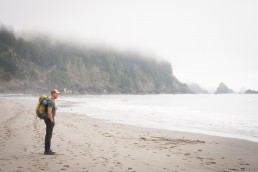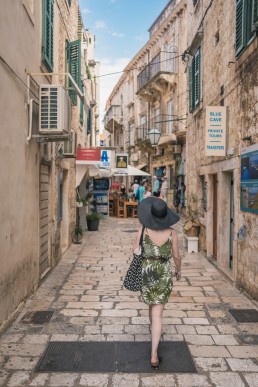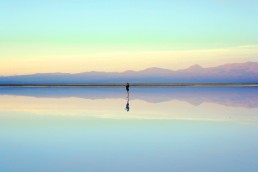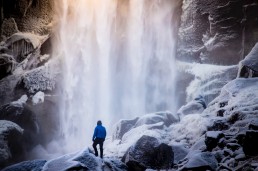How To Travel With Just Carry On
It’s a real talent to travel with only a travel on suitcase.
It’s also sometimes a smart move, especially if cost is a factor to you—your flights will often be significantly cheaper if you don’t require checked in luggage. It also makes traveling more streamline and practically easier. It’s easier to move from place to place if you’re not lugging 30kg of your belongings around after you.
My first tip for packing just a carry-on case is be ruthless. Thing about what you really really need to take with you. I don’t take anything that I think I could buy if I was in a pinch and really needed it. Toiletries often take up so much space but really, where would you be going that you wouldn’t be able to buy a small tube for your time away once you arrived?
Edit your packing. Don’t pack the night before, if you pack a week before you leave, it gives you time to go over and revise what you’ll need. This means you have longer to remember to pack everything you need, and time to take out what, on second thought, you might not actually require.
Another thing to consider is obviously where you’re going and how long you’re going away for. You won’t necessarily need a whole weeks worth of different outfits, for instance, and if you’re going to be lying on a beach most days then the amount of space you’ll need for clothing will be greatly diminished.
The key thing when packing just a carry on is packing smart and really thinking about your travel context and what it calls for.
Tips For Short Stays
When you’ve only managed to score a short time away, we get that each decision you make about your holiday seems that much more important. You feel like you’re going to miss out on the best if you chose the wrong places or activities to invest time and money into doing. We get you. So here are three great tips for making sure your budget doesn’t restrict the experience you have on holiday.
- You’re not going to see it all. So don’t beat yourself up about it. Time comes with it’s obvious limits. Prioritise what is ‘must see’ and what is just ‘would like to see’. This will tell you a lot about where to stay, what your budget will be like and how much you need to fit into each day.
- Research. Research. Know your stuff before you start booking, and even moreso before you arrive at your destination. This will mean that what you spend your valuable time on is exactly what you want to see. Leaving a holiday feeling disappointed or like there was more you should have done is awful! Save yourself that pain by finding what you’ll truly enjoy.
- Be present. When your time is precious and fleeting, make sure that you’re present and truly enjoy every moment. Don’t get bogged down in rushing around seeing everything, spend time to enjoy where you are and take in the each step of the journey.
Tips For Long Stays
When you know you’ll be traveling for a substantial period of time, the thought process around your time away is completely different to that of a quick stay abroad. Here are 5 tips for making sure you get the most from your long stay;
- Allow time for rest.
You’ll need it. Give yourself a weekend off, every few weeks. To chill and rejuvenate. This will ensure you don’t get sick, and give you time to reset before heading off again.
- Cover more ground—the smart way.Just because you’re traveling longer, this doesn’t mean you have to spend more getting to new places. If you extend the reach of where you’re already going to be, you’ll find that the backstreets, and what’s just off the tourist beaten track is well worth it. See the main attractions, and then allow for extra time to see beyond
- Budget. Budget.Your money has to stretch as far as your travels do! Be smart about budgeting, and have check-ups along the way to make sure you’re staying on track. Beware spending too much, too early.
- 50% structure, 50% “winging it”.When you’ve got a lot of time, give yourself the opportunity to properly explore and leave the rigid nature of a structured itinerary. Get lost in placed you’d usually be rushing through to get somewhere else.
- Don’t get photo lazy.Taking. Photos. Sometimes when we travel for long periods of time we can forget to document so much of it because it starts to feel like normal life. Don’t rob yourself of memories to look back on.
Traveling On A Budget
Not all of us have the finances—or desire—to travel in 5 star, first class luxury. A lot of funds isn’t necessary to go far and see a lot and some would argue you see more when you get off the beaten track, out of Touristville and see how the locals like it.
The first thing to remember when your budget is tight is that not everything worth doing actually costs money. Once you’ve spent the coin getting somewhere, walking around and experiencing the place you’re in often doesn’t cost much (if anything). You’ll find living expenses (like food, accommodation) are non-negotiable but things like going on fancy tours or spending money going to trendy restaurants and hotels can be sacrificed for the greater travel good.
Another thing worth noting is you’ll find if you have a travel buddy you’ll be less likely to do activities like shopping and extra café visits.
What are your top tips for saving coin while over seas?
Shop Like A Local
Shopping while your on holiday can be a highlight for some people, but sometimes it’s hard to break free from the touristy shops selling postcards and overpriced knick-knacks. Depending on where you’re traveling from, international shopping is often something to take advantage of, because you might be exposed to brands that you wouldn’t be able to get at home, or get your favourite brands at a cheaper pricepoint.
Outlets are great places to utilize while abroad and often times they’ll be featured in tourists brochures and advertised at hotels and hostels. They’re often easy to access, with bus companies and local public transport option being relatively easy to access and navigate your way through.
Department stores can be helpful because it’s likely a familiar format with brands that you might not be used to being able to shop with such ease. You’ll be able to get help from product specialists and see/try what you buy before you do.
Research where great shopping is! It’s often a little off the tourist beaten track, but the rewards for your efforts will be great!
Getting The Most Out Of Your Economy Seat
Flying economy can be a smart way of traveling and getting the most of your money. Spending less on getting to your destination gives you more to play with when you arrive. Economy seats can be a tight squeeze though, and particularly on long haul flights they can be uncomfortable and arduous. We’ve perfected the art of economy travel though, and here are our top pieces of advice for surviving small spaces at 39,000 feet.
Giving yourself plenty to do on the plane is a must. If your mind is occupied then you’re less likely to sit there being annoyed that you don’t have very much personal space. I always make sure that I have back up films or television shows, because if you rely on the in-flight entertainment you might not always find something you’re particularly interested in. If you’re someone who can’t read with noise going on around you (as I am) then books usually aren’t a good option on a flight. Find something that will keep you engaged and pass the time faster for you.
Get up and move frequently. This can be easier or harder depending on whether you have an isle spot or not. If you keep your muscles and body comfortable and mobile, the jittery bored feelings will remain at bay for longer. Making sure that you’re moving around enough in a flight is an excellent way of breaking it down as well, if you set a goal to get up and move around at least once and hour they’ll tick down much faster!
Relax. Which can be hard when you feel like there are a hundred other people too close to you. But finding ways to tune out of the environment as best you can you’ll find is the only way to survive with your sanity in tact.
Remember that as soon as you arrive at your destination you will have forgotten about the discomfort of getting there very quickly.
Traveling Alone
Solo travel can be one of the most invigorating experiences, and be one of the best investments you can make in yourself. I’ve spent quite a substantial amount of time on my own on the road, and it certainly presents its own challenges but the rewards far surpass these.
My first piece of advice when traveling alone is to have a pretty rigorous plan. This will help keep you safe because you can let people know where you are at all times, but it also means that you always have somewhere to look forward. A risk when traveling alone is that you’re less motivated to get out and see things, having a plan will mean that there’s always something to do, and you won’t feel you lack someone else pulling you around or suggesting locations to see.
Having said that, a great benefit of traveling alone for me has been the time for self-reflection and really appreciating and taking in where I am at any given moment. Not having someone to be distracted by means I notice more of what I’m seeing, and appreciate things in a different way. I find that I immerse myself in a local culture or environment much better when I don’t have anyone else to be concerned about or social with.
You meet people much easier in places like hostels when you’re traveling alone as well. People are more likely to include you in their social circles when it looks as though you’re there on your own – one of the great benefits of hostel culture.
A lot of the safety concerns on traveling alone, particularly if you’re female, go without saying, so I won’t get into them here. Just be cautious and don’t step too far out of your comfort zone when you’re alone.
Otherwise, I’d say make sure you journal and take lots of selfies of you in all the great places you travel to!
Documenting Your Travels
An important part of travel that is far too often overlooked is documenting the memories you make.
It's instinctual for most of us to document our time traveling with photographs, but what happens to them once we're home? All too often mine sit on a memory card only to be forgotten until the next trip comes along.
Social media has helped, in the sense that we are now good and trained at uploading memories instantaneously. These aren't comprehensive memory safe's though, only showing a day or a moment where in years to come you'll wish you remembered more than a selfie and a smart caption.
My favourite way is journaling and I find it's a relatively easy habit to get yourself into when you're traveling, much easier than when at home. I make sure to take time each day to write, even just in list form, where we went and what we saw. For the wordsmiths amongst us you may like to write a more comprehensive account, but you'll be amazed at how much memory recall you can have from even just reading the name of a place or cafe you visited.
If printing out photos isn't your thing, I'd highly recommend picking your favourite photos as you go and then having them printed into a book when you get home. We only started doing this recently, and I'm trying to organise myself into doing the same for some old trips too - there are loads of companies online that will bind your memories together and send you a gorgeous coffee table book of your adventure. This is great for showing friends and family as well as being a precious keepsake for yourself.
Yosemite National Park - Do It Now
Travel builds character. It defines who you are as a person. Being able to withstand rocky terrain physically and metaphorically shapes your decision making skills. It gives you confidence in your ability to navigate life. That’s why there’s no better time to travel than in your 20s. At what other age do you get to be gloriously selfish and adventurous?
There’s a quote by musician Henry Rollins that strikes a chord with young people. It urges them to get a passport, take a summer, and see other parts of the world. If you’re American, you may be unable to travel outside the country at first. That’s ok, there’s a world of adventure to be had in the U.S.A. You can start there and get the passport later.
Why Yosemite?
Yosemite National Park is a backpacker’s paradise. Stretching nearly 1,200 miles, it’s an outdoor treasure trove filled with natural beauty, photo opportunities, and experiences like none you’ve had before in your life. First protected in 1864, Yosemite sees its fair share of visitors each year and for good reason. Known for its breathtaking waterfalls, giant sequoias, and deep valleys, the Californian National Park offers the perfect setting for your first backpacking adventure.
Here are five reasons why backpacking in Yosemite National Park in your 20s is ideal:
• Over 95% of the land is designated Wilderness. What better way to experience the Great Outdoors than sleeping in the wild? In order to do so, you’ll need a wilderness permit. It’s free but in great demand so reserving one is highly recommended. The cost is $5 per confirmed reservation plus $5 per person if traveling in a group. Half Dome permits are now $8 per person. It’s a small price to pay for lodging on any trip you take.
• You’ll eat well and inexpensively. Running low on provisions is unheard of in Yosemite. In fact, stocking up on the foods you love and fuel your body while backpacking is easy. There are a number of places to buy food. The Village Store, the Ahwanee Sweet Shop, and Housekeeping Camp General Store are open during business hours as a convenience for visitors to the park. Purchase your favorite backpacking foods and enjoy them in one of the many picnic areas throughout Yosemite. You’re young so you know what it’s like to eat on a budget. Word to the wise: Don’t leave any scraps behind or you’ll attract bears at your campsite.
• You’ll gain a better understanding of what’s important in life. Void of many modern technologies, you’ll gain a healthy appreciation for the planet and its natural resources. You’ll see rock formations where glacier water slowly carved their surfaces for a period of over 3,000 years. You’ll stand beside ancient sequoias in Mariposa Grove and realize their significance for the first time. Rather than be distracted by electronic gadget, your focus is on the scenery ahead of you and the way it makes you feel. Make sure to document your experience with a digital camera (pack lots of batteries), a journal, and the writing tool of your choice. You won’t want to forget a moment spent in Yosemite. Cheryl Strayed built a career out of a solo hike down the Pacific Crest Trail.
• You’ll learn that earning a living and making a life for yourself are two very different things. Employment opportunities exist with or without you. It’s better to travel while you’re young, debt-free, and childless. Many people are under the assumption that entering the working world straight out of college is advantageous. They forget how hard it is to request time off. Money is almost always a factor. Once a person gets used to a certain type of lifestyle, they need a way to financially support themselves. Before buying a house, new car or designer suit, consider the value of a backpacking adventure. You’re likely to learn more than you did as a student, and this time around, your education is free.
• You’ll enjoy a variety of adventures that excite and amaze you. Yosemite offers plenty to do year round. Among the different activities promoted by the park is art and photography, auto touring, biking, birdwatching, camping, fishing, hiking, horseback riding & stock use, picnicking, ranger and interpretive programs, rock climbing, tours, volunteering, water activities, and winter sports. You could honestly choose a different activity every day and still not do everything you set out to do in the park. Part of growing as a person is challenging yourself to try new activities. Fire up the neurons in your brain by stepping out of your comfort zone.
There are a number of compelling reasons to pack a rucksack and visit Yosemite. If anything, do it because you’re young and you can. You won’t regret the experience you have. In fact, you’ll create memories that you carry with you throughout your lifetime because of your adventure.
Australia's Hidden River Gem
The Daintree River is located roughly 100 kilometers north of Cairns in far north Queensland. It is one of those hidden holiday destinations that most people don’t wont the world to know about. While Australia is famous for its fabulous beaches, coral reefs and red center, it is also home to some of the most diverse, and prehistoric, rain forests on earth.
In the Daintree region you can find both plant and animal life that dates back thousands of years, many of which are reaching a point of extinction with the rain forest their last known habitat. The Daintree River itself is a natural border that sits between 21st century man, and prehistoric times. In fact, there isn’t even a man made bridge that crosses this rain forest river. The only way to gain access to the Daintree rain forests is by vehicle ferry – but it’s certainly worth the trip.
You have two options. You can take a leisurely day trip from Cairns or Port Douglas. Visit the river and many of the sites; take in a river cruise and possibly catch site of some of the saltwater crocodiles that inhabit the region, or you can plan to stay awhile and really explore the region.
Daintree RiverThere is plenty to see in the area between the Daintree River crossing and Cape Tribulation – another hours drive north. Areas such as Cow Bay, Coconut Beach and the Cape Tribulation lookout are all worth visiting. You can dine at the Cafe by the Sea; visit the Insect Museum; or perhaps do a taste test at the Daintree Ice-Cream Company – said to be the best ice-cream north of the Daintree (hang on, it’s the only ice-cream north of the Daintree).
There are plenty of tourist lodges and resorts to stay in, or you take your own caravan – there are plenty of camping places available, all with great services to for an area so remote.
If you are looking for a holiday that’s different, consider the Daintree River and the rainforest national park to the north. You can spend a week exploring this region and never get bored. Check out the video on the Daintree River Wild Life Cruise.









